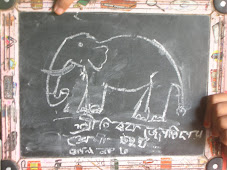Recently, data collected by the East Delhi office showed that the area still has a large number of children (c.11,000) who attend neither government school, nor Pratham’s direct (community-based) program. I spent two days in the field finding and interviewing some of these children in order to understand more about their circumstances and see how Pratham can better target this elusive group.
Visiting those bastis is something I shall never forget. The lanes were dark, narrow and filthy with open gutters, flea-ridden animals and the insects swarmed so thickly they hung like a veil across my path. The overcrowding was intense: families of five to six lived in rooms so small that I could cross them in a single stride and the smell was overpowering. Today we visited a basti in which Pratham does not operate a direct program. We asked the children whether they knew of Pratham and asked them about their levels of education, if any. We visited during school hours in the hope of catching the non-attendees at a time when parents might be at work (and children more able to answer our questions freely). We spoke to three families. In each case, we found young girls of about twelve to fourteen years at home with infant siblings, of which there were normally two or three. All three girls had lost their mothers. They told us that their fathers and brothers (often of about the same age) were working in factories making plastic home-wares such as tea strainers, or ironing and pressing clothes, and pulling rickshaws. Two girls told us that their brothers were able to read and write, although none of them had studied beyond third standard.
We had anticipated that children might have been working instead of going to school. We also suspected that many out of school children would be migrants – and they were – but not quite in the way we had expected. Many migrant families came to Delhi from rural areas for work, sometimes children came to the cities alone. Furthermore, seasonal migration prevents children from finishing their school year in the same place that they started. Today we discovered a further nuance to the problem of migration: many families and especially newly arrived migrants were constantly on the move, changing room every couple of months. But if the family moved out of their school catchment area, then the child would have to move to a new school. The process of re-enrollment was highly problematic and often children would be shut out of the school system till the beginning of the next academic year. Another girl explained that she tried to enroll her young brother in first standard, but he was ill with tuberculosis during the enrollment period. In fact, he was still weak and not yet fully recovered, and she said she would try to enroll him again next year.
The children talked of other barriers to education: the associated costs of school (school uniform, birth certificates etc) were too high, and fears of allowing children to walk to and from school alone. However, there was strong support for a direct program and general desire to attend school was high. It was interesting for me to be able to see the thorough planning and data collection process, to view the questionnaire design and the uninhibited interaction of the Pratham staff with the community. Pratham’s interventions thrive on community support and public will to bring about change, especially in the face of government underprovision. I left the field feeling happy and optimistic that before even establishing a presence in the basti, Pratham’s staff were excellent ambassadors for the cause and had sewn the first seeds of a good future relationship with the people we met today
______________________________________________________
www.readindia.org
www.pratham.org.uk
www.prathamusa.org
www.pratham.org
Tuesday, August 12, 2008
Subscribe to:
Post Comments (Atom)

No comments:
Post a Comment